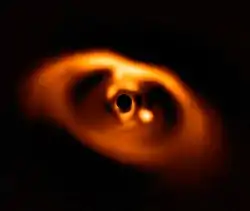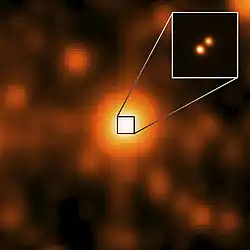Kepler-76b
Kepler-76b is a gas giant with the mass about two times of Jupiter.[2]
| Discovery | |
|---|---|
| Discovery date | May, 2013 |
| Stellar flux variations due to relativistic beaming, Transit (Kepler Mission) | |
| Orbital characteristics | |
| 0.028 AU | |
| Eccentricity | ~0 |
| 1.54492875 d | |
| Inclination | 78 |
| Star | Kepler-76 |
| Physical characteristics | |
Mean radius | 1.25 RJ |
| Mass | ~2 MJ |
Mean density | 1.4 g/cm3 (0.051 lb/cu in) |
| Albedo | 0.23 (visible light) |
| Temperature | 2165[1] |
It is a Hot Jupiter that orbits its star every 1.5 days. It was confirmed with the Trans-Atlantic Exoplanet Survey and the SOPHIE échelle spectrograph.
Detection
The planet was discovered by observing the amount of stellar flux reaching the Earth. The existence of the planet was confirmed by also observing the reflected starlight from the planet, the shape of the star due to gravitational tug from the planet and radial velocity method. Finally, part of the planet was found transiting the parent star with secondary occultation also being detected.[2][3]
It is the first planet detected using Einstein's special relativity.
Characteristics
Kepler-76b is slightly denser than Jupiter indicating that it is not a puffy planet.
References
- A Comprehensive Study of Kepler Phase Curves and Secondary Eclipses:Temperatures and Albedos of Confirmed Kepler Giant Planets
- Faigler, S.; et al. (2013). "BEER Analysis of Kepler and CoRoT Light Curves. I. Discovery of Kepler-76b: A Hot Jupiter with Evidence for Superrotation". The Astrophysical Journal. 771 (1). 26. arXiv:1304.6841. Bibcode:2013ApJ...771...26F. doi:10.1088/0004-637X/771/1/26.
- "New Method of Finding Planets Scores its First Discovery". kepler.nasa.gov. Retrieved May 14, 2013.
External links
- Table of confirmed planets at NASA, Kepler mission



